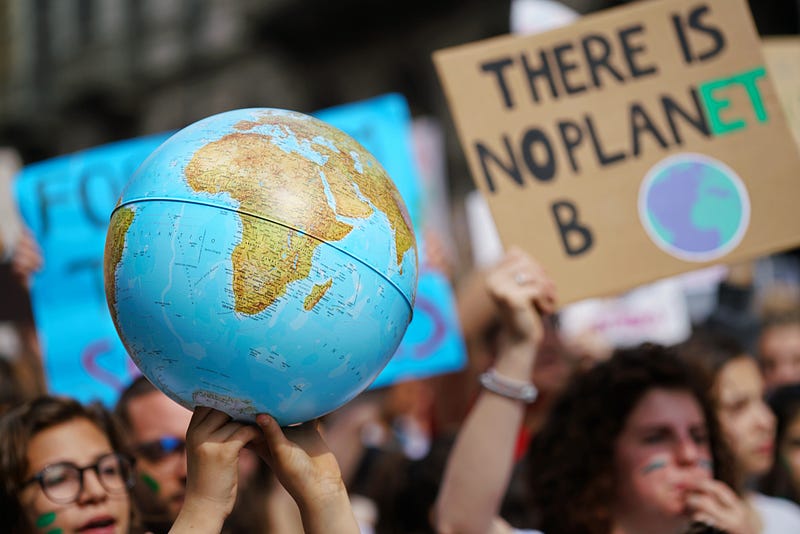The Origins of the Climate Crisis: Leading to an Uncertain Future
By Julia Hines, Chemical Engineering, 2021

The Climate Crisis has filled the news lately with the rise of Greta Thunberg, a sixteen year old climate activist, and many youth-led protests across the globe. Thunberg’s insistence of action has reverberated around the world. She has made Europe and the United States listen, proclaiming during one rally that “adults keep saying we owe it to the young people to give them hope. But I don’t want your hope. I want you to panic”. However, this raises the question: how did we get into this position?
The greenhouse gas effect has been mentioned in scientific literature since the late 1800s. However, the connection between human-generated carbon dioxide emissions and the greenhouse gas effect wasn’t made until the early 1900s. Before this time, it was commonly assumed that humans could not change the heat balance or climate of the earth because the total power from all human activity (8 trillion Watts) is insignificant next to the power of the sun’s radiation (80 quadrillion Watts). During the Industrial Revolution, cities started to develop a thin layer of smog that hung overhead. Of course, this is climate change, but it is regional climate change. The effects of this smog did not reach all the way across the globe.
To fully understand climate change, one must first understand the greenhouse effect. It’s caused by carbon dioxide, methane, water vapor, and several other trace gases — together known as greenhouse gases — that absorb infrared (IR) radiation. As the sun’s light hits the Earth’s surface, some IR radiation is reflected off Earth and back into space. These greenhouse gases prevent some reflected radiation from escaping to space which, in turn, warms the lower atmosphere and the surface.
The effects of climate change are coming faster, and more intensely, than any scientists predicted.
The first mention of this in scientific literature was by Jean Baptiste-Joseph Fourier in 1824. In 1864, John Tyndall scientifically proved that water vapor and carbon dioxide could absorb IR radiation, meaning atmospheric conditions could change the Earth’s temperature. Finally, at the turn of the century, Swedish scientist Svante Arrhenius calculated that doubling the then current carbon dioxide levels in the atmosphere would raise the average surface temperature by five to six degrees Kelvin. Despite all of these discoveries, there was still no acknowledged link between human activity and the increase in carbon dioxide emissions or global temperature.
In the 1950s, the ideas of anthropogenic climate change and the need for “climate control” were introduced by scientists John Von Neumann, Roger Revelle, and Hans Seuss. It wasn’t until 1965 that the President’s Science Advisory Committee addressed air and water pollution, making it the first time the U.S. government publicly acknowledged climate change. In 1970, a group of scientists formed the Study of Critical Environmental Problems (SCEP). This produced a dire warning that the potential long-term consequences of CO2 on the climate are extremely serious and need to be researched and monitored more. This warning worked: in 1972, the UN had its first meeting on the “human environment”. And in 1995, the Intergovernmental Panel on Climate Change (IPCC) — backed by the World Meteorological Organization and the United Nations Environmental Program — stated, “the balance of evidence suggests a discernible human influence on global climate.”
Flash forward to today: 24 years later, little action has been taken. The effects of climate change are coming faster, and more intensely, than any scientists predicted. Major changes in weather — in addition to larger, more powerful storms — have already started.
There was a dire warning that the potential long-term consequences of CO2 on the climate are extremely serious and need to be researched and monitored more.
In 2013, the first large international treaty, the Paris Agreement, was agreed upon to combat climate change. The general goal of this agreement was to strengthen the global response to climate change to limit the global temperature rise to below a 2 degree Celsius rise from pre-industrial levels. 196 countries have signed the agreement, and 183 countries have ratified this agreement.
Some, like Thunberg, believe that the world isn’t doing enough. Despite the unprecedented Paris Agreement, some countries are not actively taking steps to combat climate change. The US pulled out of the agreement and has rolled back many environmental protection policies in recent years. However, some countries are doing more than their part; smaller countries like Tunisia and Peru have started cracking down on dumping hazardous waste. With the speed of the effects of climate change being disputed, the future seems uncertain. However, without major action from large countries, there is little that can be done to solve the crisis.
Nature (2016), DOI: 10.1038/nature19082
The Royal Society Publishing (1864), DOI: 10.1098/rstl.1864.0005
